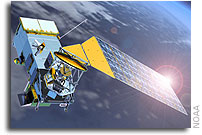Polar-Orbiting Operational Environmental Satellites: Technical Problems, Cost Increases, and Schedule Delays Trigger Need for Difficult Trade-off Deci

Polar-orbiting environmental satellites provide data and imagery that are used by weather forecasters, climatologists, and the military to map and monitor changes in weather, climate, the oceans, and the environment. Our nation’s current operational polar-orbiting environmental satellite program is a complex infrastructure that includes two satellite systems, supporting ground stations, and four central data processing centers. In the future, the National Polar-orbiting Operational Environmental Satellite System (NPOESS) is to combine the two current systems into a single, state-of-the-art environment-monitoring satellite system.
This new satellite system is considered critical to the United States’ ability to maintain the continuity of data required for weather forecasting and global climate monitoring through the year 2020. GAO was asked to discuss the NPOESS program’s schedule, cost, trends, and risks, and to describe plans and implications for moving the program forward.
The NPOESS program has experienced continued schedule delays, cost increases, and technical challenges over the last several years. The schedule for the launch of the first satellite has been delayed by at least 17 months (until September 2010 at the earliest), and this delay could result in a gap in satellite coverage of at least 3 years if the last satellite in the prior series fails on launch. Program life cycle cost estimates have grown from $6.5 billion in 2002 to $8.1 billion in 2004 and are still growing.
While the program is currently reassessing its life cycle cost estimates, our analysis of contractor trends as of September 2005 shows a likely $1.4 billion contract cost overrun–bringing the life cycle cost estimate to about $9.7 billion. Technical risks in developing key sensors continue, and could lead to further cost increases and schedule delays. As a result of expected program cost growth, the Executive Committee responsible for the program is evaluating options for moving the program forward–and new cost estimates for those options. Key options under consideration in August 2005 included removing a key sensor from the first satellite, delaying launches of the first two satellites, and not launching a preliminary risk-reduction satellite. All of these options impact the program’s cost, schedules, and the system users who rely on satellite data to develop critical weather products and forecasts–although the full extent of that impact is not clear.
Further, last week GAO was informed that there are nine new options now under consideration, and that they are likely to impact costs, schedules, and system users. Until a decision is made, the program remains without a plan for moving forward. Further, there are opportunity costs in not making a decision–some options are lost and others may become more difficult. Given the history of large cost increases and the factors that could further affect NPOESS costs and schedules, continued oversight, strong leadership, and timely decision making are more critical than ever.








